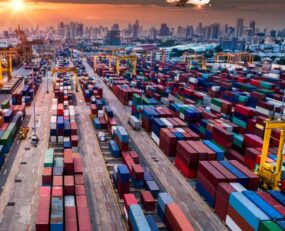
One of the major reasons for the congestion in sea routes across the Pacific has been the surge in trade out of China over the past six months. This surge appears to be increasing in scale. The most recent figures from the Chinese Customs Administration, released today, show exports growing by 14.9% year-on-year in November but imports falling by 0.8%. Compared to October exports grew by 11.1% and for the year-to-date growth was 3.7%.
Before leaping to conclusions about a wave of exports hitting the US, Chinese Customs commented that the “Association of Southeast Asian Nations remained China’s largest trading partner during the period, followed by the European Union and the United States.” None-the-less this performance has resulted in the largest Chinese monthly trade surplus on record, at least in nominal terms, with exports exceeding imports by CNY 500bn or approximately US$76bn. This represents around 6% of Chinese GDP, which is high in gross-terms but less than the trade surplus often run by Germany if measured in term of proportion of GDP.
Although the export picture over the past year has been affected by the exceptional demand for medical ‘PPE’ equipment, items such as electronic consumer durables remain the foundation of exports across the Pacific at least.
What is notable, although not exceptional, about these numbers is what they tell us about the trajectory of the Chinese economy and how it relates to the rest of the world. After the COVID-19 crisis in China, the Chinese government embarked on a large stimulus ‘package’ aimed at restoring growth. This is hardly unusual for any government at present, however the way in which the Chinese did this was characteristic of the structure of their economy. It favoured subsidies to producers – especially the ‘State -Owned Enterprises’ – and neglected consumers. The unsurprising result is a reduction in imports for consumption and a rise in production that has been exported.
The implications for world trade and trading patterns are significant. Other economies round the world have embarked on huge fiscal deficits to sustain recoveries from the crisis, led by attempts to stimulate private consumer domestic demand. This will result in increases in imports. Even the Germans have done this. However, if a major economy such as China pursues the reverse strategy trade will become increasingly unbalanced. For the logistics sector the implication is that problems over capacity availability in shipping, airfreight and containers will continue or possibly get worse.
Source: Transport Intelligence, December 8, 2020.
Author: Thomas Cullen